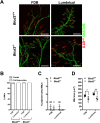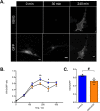Loss of BICD2 in muscle drives motor neuron loss in a developmental form of spinal muscular atrophy
- PMID: 32183910
- PMCID: PMC7076953
- DOI: 10.1186/s40478-020-00909-6
Loss of BICD2 in muscle drives motor neuron loss in a developmental form of spinal muscular atrophy
Abstract
Autosomal dominant missense mutations in BICD2 cause Spinal Muscular Atrophy Lower Extremity Predominant 2 (SMALED2), a developmental disease of motor neurons. BICD2 is a key component of the cytoplasmic dynein/dynactin motor complex, which in axons drives the microtubule-dependent retrograde transport of intracellular cargo towards the cell soma. Patients with pathological mutations in BICD2 develop malformations of cortical and cerebellar development similar to Bicd2 knockout (-/-) mice. In this study we sought to re-examine the motor neuron phenotype of conditional Bicd2-/- mice. Bicd2-/- mice show a significant reduction in the number of large calibre motor neurons of the L4 ventral root compared to wild type mice. Muscle-specific knockout of Bicd2 results in a similar reduction in L4 ventral axons comparable to global Bicd2-/- mice. Rab6, a small GTPase required for the sorting of exocytic vesicles from the Trans Golgi Network to the plasma membrane is a major binding partner of BICD2. We therefore examined the secretory pathway in SMALED2 patient fibroblasts and demonstrated that BICD2 is required for physiological flow of constitutive secretory cargoes from the Trans Golgi Network to the plasma membrane using a VSV-G reporter assay. Together, these data indicate that BICD2 loss from muscles is a major driver of non-cell autonomous pathology in the motor nervous system, which has important implications for future therapeutic approaches in SMALED2.
Keywords: BICD2; DYNC1H1; Hereditary motor neuropathy; Muscle; SMALED2; Spinal muscular atrophy.
Conflict of interest statement
The authors declare that they have no competing interests.
Figures






Similar articles
-
Novel insights into SMALED2: BICD2 mutations increase microtubule stability and cause defects in axonal and NMJ development.Hum Mol Genet. 2018 May 15;27(10):1772-1784. doi: 10.1093/hmg/ddy086. Hum Mol Genet. 2018. PMID: 29528393
-
Phenotypic and molecular insights into spinal muscular atrophy due to mutations in BICD2.Brain. 2015 Feb;138(Pt 2):293-310. doi: 10.1093/brain/awu356. Epub 2014 Dec 14. Brain. 2015. PMID: 25497877 Free PMC article.
-
SMALED2 with BICD2 gene mutations: Report of two cases and portrayal of a classical phenotype.Neuromuscul Disord. 2020 Aug;30(8):669-673. doi: 10.1016/j.nmd.2020.05.009. Epub 2020 Jun 6. Neuromuscul Disord. 2020. PMID: 32709491
-
Neurogenic arthrogryposis and the power of phenotyping.Neuromuscul Disord. 2021 Oct;31(10):1062-1069. doi: 10.1016/j.nmd.2021.07.399. Epub 2021 Oct 9. Neuromuscul Disord. 2021. PMID: 34736627 Review.
-
The Genotypic and Phenotypic Spectrum of BICD2 Variants in Spinal Muscular Atrophy.Ann Neurol. 2020 Apr;87(4):487-496. doi: 10.1002/ana.25704. Ann Neurol. 2020. PMID: 32057122 Review.
Cited by
-
Humans: the ultimate animal models.J Neurol Neurosurg Psychiatry. 2020 Nov;91(11):1132-1136. doi: 10.1136/jnnp-2020-323016. Epub 2020 Aug 7. J Neurol Neurosurg Psychiatry. 2020. PMID: 32769113 Free PMC article. Review. No abstract available.
-
Cargo specificity, regulation, and therapeutic potential of cytoplasmic dynein.Exp Mol Med. 2024 Apr;56(4):827-835. doi: 10.1038/s12276-024-01200-7. Epub 2024 Apr 1. Exp Mol Med. 2024. PMID: 38556551 Free PMC article. Review.
-
A novel BICD2 mutation of a patient with Spinal Muscular Atrophy Lower Extremity Predominant 2.Intractable Rare Dis Res. 2021 May;10(2):102-108. doi: 10.5582/irdr.2021.01004. Intractable Rare Dis Res. 2021. PMID: 33996355 Free PMC article.
-
Methodological advances for studying gamma motor neurons.Curr Opin Physiol. 2021 Feb;19:135-140. doi: 10.1016/j.cophys.2020.10.002. Epub 2020 Oct 14. Curr Opin Physiol. 2021. PMID: 36561377 Free PMC article.
-
The node of Ranvier influences the in vivo axonal transport of mitochondria and signaling endosomes.iScience. 2024 Oct 11;27(11):111158. doi: 10.1016/j.isci.2024.111158. eCollection 2024 Nov 15. iScience. 2024. PMID: 39524336 Free PMC article.
References
-
- Neveling K, Martinez-Carrera LA, Hölker I, Heister A, Verrips A, Hosseini-Barkooie SM, et al. Mutations in BICD2, which encodes a golgin and important motor adaptor, cause congenital autosomal-dominant spinal muscular atrophy. Am J Hum Genet. 2013;92:946–954. doi: 10.1016/j.ajhg.2013.04.011. - DOI - PMC - PubMed
Publication types
MeSH terms
Substances
Grants and funding
LinkOut - more resources
Full Text Sources
Molecular Biology Databases

